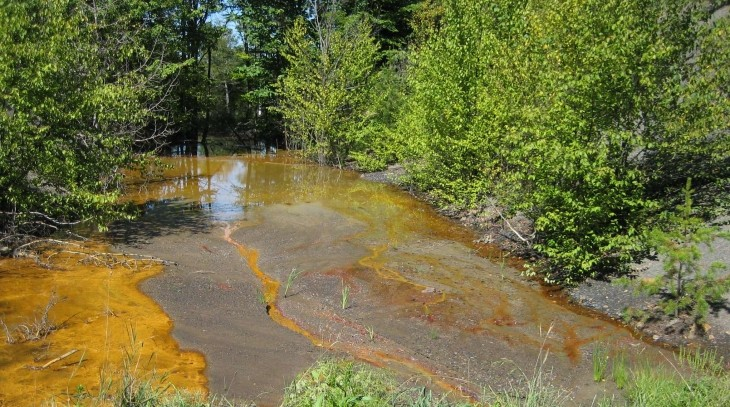Novel Method to Retrieve Rare Earth Elements from Acid Mine Drainage
Published on by Water Network Research, Official research team of The Water Network in Technology
According to researchers at Penn State, a new method for treating acid mine drainage (AMD) could enable the conversion of the environmental pollution issue into a vital domestic source of the critical rare earth elements that are required for the manufacture of technology varying right from smartphones to fighter jets.

Acid mine drainage pollution in a stream in Cambria County, Pennsylvania. Image Credit: Penn State.
Acid mine drainage has been a significant environmental concern for many decades . This research shows we can modify existing treatment processes in a way that not only addresses environmental concerns, but at the same time recovers valuable elements and actually decreases the cost of treatment .
Mohammad Rezaee, Assistant Professor, Mining Engineering, College of Earth and Mineral Sciences, Penn State
A research group from Penn State has designed a two-stage treatment process that allows higher concentrations of rare earth elements to be retrieved using smaller amounts of chemicals compared to what was possible earlier.
This technique represents an efficient, low-cost and environmentally friendly method to extract these valuable minerals that are used in a wide variety of consumer and industrial products .
Sarma Pisupati, Professor of Energy and Mineral Engineering, Director of the Center for Critical Minerals, Penn State
Rare earth elements are a family of 17 minerals commonly used in sophisticated technologies and named by the United States as crucial to the country’s national and economic protection. At present, the United States imports around 100% of such materials, where China produces around 85% of the global supply.
According to the researchers, AMD derived from coal mining operations in Appalachia constitute a potential domestic source of rare earth elements since it usually consists of these minerals in high concentrations, and since it is already being gathered and treated as a result of environmental issues.
We are currently incurring costs just to treat the water, and in many cases, we are not even collecting all these minerals . Now we are able to turn what had been considered a waste product into a valuable resource .
Sarma Pisupati, Professor of Energy and Mineral Engineering, Director of the Center for Critical Minerals, Penn State
AMD forms as a result of the interaction of pyrite rock—iron sulfide—unearthed by mining activity with air and water and its further oxidization, which leads to the formation of sulfuric acid. Then, the acid breaks down surrounding rocks, resulting in dissolving of the toxic metals into water.
Conventional treatment techniques include the collection of the AMD in retention ponds and the addition of chemicals to neutralize the pH—an indicator that shows how basic or acidic a substance is.
This causes precipitation of the dissolved metals, or their conversion into solids, where they settle out of the water. Nearly 70% of rare earth elements can be derived as a sludge through this process, and the leftover is discharged along with the treated water.
The researchers identified that a higher concentration of rare earth elements and other crucial minerals can be extracted by adding carbon dioxide to the AMD and bringing it to a neutral pH of 7, which is the goal for environmental remediation, in two individual steps.
By employing this technique, 85% of rare earth elements were recovered at a pH of 7 and 90% of aluminum was retrieved at a pH of 5. This was reported by the researchers in the Chemical Engineering Journal .
According to the researchers, the addition of carbon dioxide to AMD generates chemical reactions that lead to the formation of solid minerals known as carbonites. The rare earth elements tend to bind with the additional carbonites and precipitate out of the water at lower pH values.
Taxonomy
- Heavy Metal Removal
- Minerals Recovery
- Mine Drainage
- Acid-base Chemistry
1 Comment
-
Interesting and essential to adress common pollution isses with basemetal & coal mines; serve dual purpose - pollution control and augmenting stategegic minetal resources.